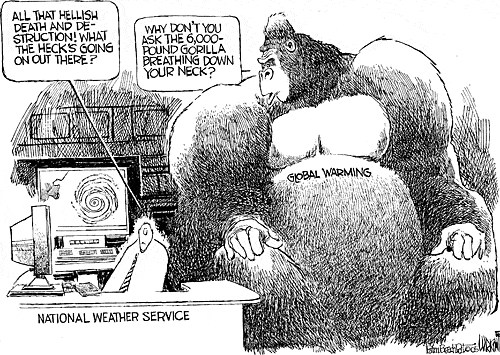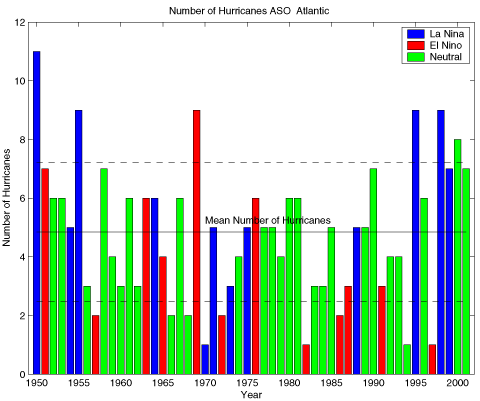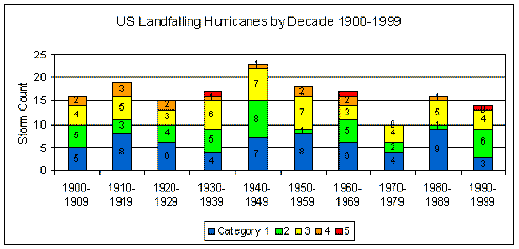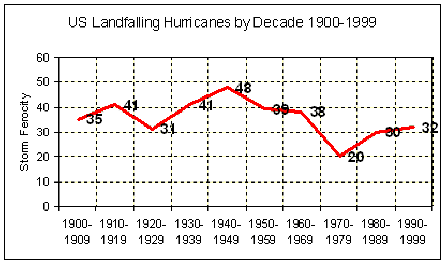
OF HURRICANES AND EVANGELICALS
William S. Abruzzi
(2009)
"There is something fascinating about science. One gets such wholesale returns of conjecture out of a trifling amount of fact."
--Mark Twain
In 1985, Pat Robertson claimed that through prayer and intersession with God he was able to divert Hurricane Gloria, a Category 4 hurricane, away from Virginia where it threatened to unleash death and destruction. For some reason, however, God didn’t seem as concerned about Long Island and Boston, since he let Gloria inflict its havoc there. (Perhaps that is because New York and Massachusetts are blue states, not red ones like Virginia.) In any case, Robertson proclaimed the power of prayer and good Christian living to alter the course of natural events.
The evangelicals are at it again. One Kuwaiti official has apparently labeled Hurricane Katrina a “soldier of Allah”. At the same time. a group calling itself Columbia Christians for Life apparently claimed that the satellite image of Katrina as it was about to hit the Gulf Coast resembled a six-week old fetus. Meanwhile, even before Katrina wreaked havoc on New Orleans and the Gulf Coast, numerous environmentalist have claimed that Katrina is just the most recent example of the increasing frequency and destructive power of hurricanes caused by global warming. As the political cartoon below illustrates, unlike the other claims that have been made, the latter belief has increasingly become accepted by the mainstream media.

This past summer, MIT climatologist Kerry Emanuel reported in the journal Nature that major storms in both the Atlantic and the Pacific have increased in duration and intensity by about 50% since the 1970s and suggested that there may be a link between global warming and hurricane formation, pointing out that global temperatures have been rising along with carbon-dioxide emissions during the same period. However, it is inappropriate to extrapolate long-term weather trends from an analysis of hurricanes over a mere 25 years. As the chart below indicates, the early 1970s displayed an especially low number of hurricanes. Thus, beginning an analysis of hurricanes in the 1970s would show an increasing trend in both the number and intensity of storms. Extending the time period by only 25 years (1950–2000), however, substantially compromises the claim of increasing hurricane frequency. There were as many hurricanes during the 1950s and 1960s, before the lull of the 1970s, as there were during the 1980s and 1990s. Similarly, the 1950s experienced just as many hurricanes as the 1990s. Hurricanes have apparently occurred during the 20th century in roughly 30-year cycles. From the 1930s through the 1960s, the southeastern coast of the United States experienced a high number of hurricanes. This was followed by a relatively quiet period for hurricanes from the 1970s through early 1990s. During the last decade, however, the frequency and intensity of hurricanes have increased again. What emerges is a cyclical, not linear, trend.
Hurricanes and Tropical Storms: 1886 – 2000

International Research Institute for Climate Prediction
If we extend the dates further back in time, the claim of increasing hurricane frequency becomes even weaker. The chart below graphs the occurrence of hurricanes over the past century. The black portion of each bar represents the number of hurricanes in any single year, while the unfilled portion of each bar represents the number of tropical storms in any single year. As is clear from the chart, although the number of storms fluctuates quite dramatically from year to year, there is no visible trend of increasing number of hurricanes or of increasing hurricanes relative to tropical storms.
Hurricanes and Tropical Storms: 1886 – 1996
Hurricanes = shaded portion of bars
Tropical Storms = unshaded portion of bar

All one needs to do in order to reinforce the notion that weather patterns are highly variable is to examine the climatic history of any single location over a long period of time. The chart below, taken from The National Oceanographic and Atmospheric Association (NOAA) web page on The North American Drought: A Paleo Perspective displays variation in climate in northwestern New Mexico during the past 2,000 years. Not only did this region experience dozens of alternating cycles of above and below normal precipitation, but it also witnessed three separate 100+ year periods in which below normal precipitation persisted, as well as both a period of sharply increased rainfall that lasted throughout much of the 5th century and a severe drought that persisted for several decades during the late 16th and early 17th centuries. This chart provides a clear warning against postulating long-term trends on too few years.
CLIMATE IN NEW MEXICO: 200BC – 2000AD

Similarly, the claim that hurricanes have become more powerful and more destructive due to global warming is also not supported by the data. Despite the fact that Katrina will easily be the costliest and deadliest hurricane in American history, it was not the most powerful. The extent of damage caused by Katrina will be due as much to inadequate flood control and the dubious wisdom of building a city in a basin located below sea level and bordered by three major bodies of water (The Mississippi River, The Gulf of Mexico and Lake Pontchartrain) as to the destructive power of Katrina. Katrina actually dropped from a Category 5 to a Category 4 hurricane before hitting land. Hurricane Andrew (1992) was the most recent Category 5 hurricane, preceded by Camille (1969) and the very deadly “Labor Day” storm of 1935. According to The Most Intense Hurricanes in the United States 1900-2000 (another NOAA web page), only 28 of the 65 Category 3 or higher hurricanes listed occurred since 1950. In addition, of the 15 Category 4 or 5 hurricanes identified by NOAA, 9 occurred before 1950, while only 6 occurred since 1950. Furthermore, of the 6 that did occur since 1950, fully 4 occurred during the 20-year period between 1950-1969, while only 2 occurred during the 30-year period between 1970-1999. The distribution and relative ferocity of hurricanes over the past century is illustrated in the two charts below that are based on NOAA’s data on U.S. hurricane Strikes by Decade. Both charts clearly show no increase in either the number or intensity of hurricanes as a result of global warming. Indeed, since Katrina, the media have been filled with dire predictions of even more Katrina-like hurricanes in 2006. The fact is that as of the one-year anniversary of Hurricane Katrina (August 29, 2006), not only had there not been a single major hurricane during the 2006 hurricane season, but there had not been as many hurricanes. Whereas by August 29, 2005, naming had reached the letter K (Katrina), on August 29, 2006 the National Weather Service was tracking the rather feeble Hurricane Ernesto (E). Furthermore, not one hurricane hit the U.S. during the entire 2006 hurricane season. Similarly, by the anniversary of Katrina in 2007, only 4 hurricanes had been named, compared to 11 by the same date in 2005, and only 7 hurricanes occurred by the same date in 2008.


The claim that humans are changing the weather and the climate by their activities is not new. During the 1870s, when pioneers were expanding westward and breaking up the sod in order to plant crops, a period of increasing moisture coincidentally occurred throughout the Mid-West. “Rain follows the plow” became the cry of community boosters and the promoters of western colonization. This cry became a national slogan, validated by “scientific” research that encouraged thousands of individuals to establish homesteads in the West and, thus, colonize what previously been viewed as “The Great American Desert”. Unfortunately for many of those who went west, the cycle of drought and rain that has characterized the Mid-West for several millennia produced two decades of recurring droughts during the 1880s and 1890s. Many of those who had heeded the call to “Go West young man” were forced to abandon the farms they had established barely a decade earlier. With the advent of the Industrial Age, people blamed an increase in tornadoes on trains and steam produced by locomotives. Radio antennas later replaced steam as a perpetrator of changes in the weather and climate. Now, global warming is the culprit blamed for the supposed increase in violent weather throughout the globe.
Eventually, however, the present hysteria over global warming and violent weather is likely to dissipate, as did previous unsubstantiated claims. At one time Americans were told that we would be inundated with our own garbage, as the U.S. was quickly running out of space to build landfills. This obviously did not happen despite continuing population growth and economic development in the U.S., the very factors that were supposed to have created the problem in the first place. If a problem ever existed, it was due to NIMBY, not to a shortage of land. Doomsayers also claimed that the planet would be overrun and depleted of resources by tens of billions of humans by the end of the 21st century who would be increasingly faced with poverty and starvation. This dire prediction also never materialized. Despite localized problem areas, most notably in Africa, there is no global shortage of food, and living standards throughout most of the world have steadily increased. In addition, according to current U.N. projections, global population growth is expected to peak at about 9 billion people by the middle of the century and then likely decline, given that more than two-thirds of the countries in the world –including India and China— currently sustain fertility levels below the replacement rate.
In conclusion, if history is any guide, then Hurricane Katrina is not a sign that we are approaching global climatic Armageddon, but rather represents nothing more than the periodic reoccurrence of particularly devastating storms. However, even though the data suggests otherwise, those who are convinced of the connection between hurricanes and global warming will continue to view Katrina as a harbinger of doom.
* * * * * * * *
Of Related Interest:
Sociopolitical Implications of the Western Concern
|
|
|
|
|
|
* * * * * * * *
|
|
|
|